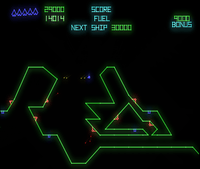Gravitar
| Gravitar | |
|---|---|
 American arcade flyer for Gravitar | |
| Developer(s) | Atari, Inc. |
| Publisher(s) | Atari, Inc. |
| Designer(s) | Mike Hally, Rich Adam, Joe Coddington(hardware) |
| Artist(s) | Brad Chaboya(cabinet) |
| Platform(s) | Arcade, Atari 2600 |
| Release date(s) | 1982 |
| Genre(s) | Multi-directional shooter |
| Mode(s) | One or two players alternating turns |
| CPU | 6502 |
| Sound | POKEY × 2 |
| Display | Horizontal, vector |
Gravitar is a color vector graphics arcade game released by Atari, Inc. in 1982. Using the same rotate-and-thrust controls as Asteroids, Gravitar was known for its difficulty.[1] It was the first of over twenty games Mike Hally designed and produced for Atari, including Star Wars. The main programmer was Rich Adam and the cabinet art was designed by Brad Chaboya. Over 5,427 cabinets were produced.[2]
Gameplay
The player controls a small blue spacecraft. The game starts in a fictional solar system with several planets to explore. If the player moves his ship into a planet, he will be taken to a side-view landscape. Unlike many other shooting games, gravity plays a fair part in Gravitar: the ship will be pulled slowly to the deadly star in the overworld, and downward in the side-view levels.
The player has five buttons: two to rotate the ship left or right, one to shoot, one to activate the thruster, and one for both a tractor beam and force field. Gravitar, Asteroids, Asteroids Deluxe and Space Duel all used similar 5-button controlling system.
In the side-view levels, the player has to destroy red bunkers that shoot constantly, and can also use the tractor beam to pick up blue fuel tanks. Once all of the bunkers are destroyed, the planet will blow up, and the player will earn a bonus. Once all planets are destroyed, the player will move onto another solar system.
The player will lose a life if he crashes into the terrain or gets hit by an enemy's shot, and the game will end immediately if fuel runs out.
Gravitar has 12 different planets. Red Planet is available in all 3 phases in the universe; it contains a reactor. Shooting the reactor core activates a link. Escaping the reactor successfully moves the player to the next phase of planets, awards bonus points and 7500 units of fuel. Reactor escape time reduces after each phase and eventually becomes virtually impossible to complete.


After completing all 11 planets (or alternatively completing the reactor three times) the player enters the second universe and the gravity will reverse. Instead of dragging the ship towards the planet surface, the gravity pushes it away. In the third universe the landscape becomes invisible and the gravity is positive again. The final, fourth universe, has invisible landscape and reverse gravity. After completing the fourth universe the game starts over. However, the reactor escape time will never reset back to high levels again.
The programmers thought that even the best players could never complete the most difficult planets on the invisible levels.[3]
Ports
On the 24th of March 2010, Gravitar was added onto the Xbox 360 and Games for Windows LIVE service, Game Room at a price point of 240 MS Points for a one-platform purchase, or 360 MS Points for a purchase on both platforms. For 40 MS Points, a user could play a one-off game. In July 2010, the Atari 2600 version of Gravitar was added to Game Room as well.
Gravitar is included within the Atari Anthology for Windows & Xbox, and PlayStation 2 and was also included on Atari Anniversary Edition Vol. 2 for Dreamcast, PlayStation and PC. A port of Gravitar was also released on the Atari Flashback 3.
The silver label version of Atari 2600 Gravitar was originally only available to Atari Club members. It was later sold in stores in limited quantities. Atari later released it in the red box and label style in large quantities. The silver label is very desirable to collectors for its rarity and association with the Atari Club.[4]
Legacy
Gravitar inspired Thrust, XPilot and Oids.
Records
Dan Coogan, of Phoenix, Arizona, United States set a new Gravitar world record, scoring 8,029,450 points on December 22–23, 2006, playing for 23 hours and 15 minutes. The previous world record was 4,722,200, which lasted for 24 years, set by Ray Mueller of Boulder, Colorado, also U.S., on December 4, 1982, playing for 12 hours and 21 minutes.[5]
Prototypes
A prototype of Gravitar was developed, called Lunar Battle. Gameplay is very similar, but there are a number of differences.[6]
Black Widow conversion
Black Widow was offered as a conversion kit for Gravitar. The kit included a new marquee, control panel, side art, and an additional wiring harness. The kit used the original Gravitar PCB, with a few small modifications and a new set of ROM chips. Many factory-built Black Widows were produced using unsold Gravitar cabinets, and although they contain original (not Gravitar conversion) board sets, they had Black Widow side art applied over the Gravitar sideart.
References
- ↑ "Gravitar". AtariProtos.com.
- ↑ http://www.andysarcade.de/gravitar.html
- ↑ "Interview with Mike Hally and Rich Adam". Retrieved 2012-04-10.
- ↑ "AtariAge information of Atari 2600 home version.". Retrieved 2012-04-22.
- ↑ "Twin Galaxies". Retrieved 2008-03-09.
- ↑ "Dan Coogan's Lunar Battle information in his comprehensive Gravitar site". Retrieved 2012-04-18.
External links
- Gravitar at the Killer List of Videogames
- Gravitar at the Arcade History database
- Dan Coogan's Gravitar Page
- Videos of Gravitar advanced gameplay
- Gravitar history and legacy in the 8 Bit Horse Blog